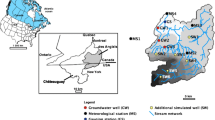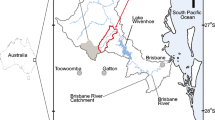Abstract
Recharge is a key parameter in groundwater resources management, and a reliable estimate of recharge is required for their sustainable development. Several methods are available to evaluate recharge; however, selecting the appropriate one is made difficult because each method has its advantages and drawbacks, and results can vary greatly from one method to another. Recharge methods can actually refer to different processes. This paper compares and discusses the results obtained from five regional-scale recharge assessment approaches applied to a fractured rock aquifer in a region with a temperate and humid climate (Annapolis Valley, Nova Scotia, Canada). These methods are distinguished between those providing estimates of the net infiltration (I) into the subsurface (river hydrograph separation and soil moisture balance) from those considering the net recharge (W) to the regional bedrock aquifer (river 7-day low-flows, the corrected soil moisture balance, a numerical groundwater flow model developed with FEFLOW and an infiltration model developed with HELP). The estimated net infiltration ranges from 160 to 250 mm/year, whereas the net recharge estimates range from 80 to 175 mm/year for the entire study area. Although different assessment methods were used, the estimated recharge range is still quite large, demonstrating the importance of using several methods. This case study should provide guidance on choices to be made in the development of a strategy for assessing representative values of aquifer recharge at the regional scale under similar geological and climatic conditions. The use of multiple complementary approaches should lead to a better understanding of the system dynamics and to better defined a representative range of recharge estimates.













Similar content being viewed by others
References
Arnold JG, Muttiah RS, Srinivasan R, Allen PM (2000) Regional estimation of base flow and groundwater recharge in the Upper Mississippi river basin. J Hydrol 227:21–40
CBCL Limited (2009) Groundwater Use Database—Methodology and Data Summary, Annapolis Valley, Nova Scotia; Technical Report
Chapman TG (1991) Comment on “Evaluation of automated techniques for base flow and recession analysis” by RJ Nathan and TA McMahon. Water Resour Res 27(7):1783–1784
Cherkauer DS (2004) Quantifying ground water recharge at multiple scales using PRMS and GIS. Ground Water 42(1):97–110
Chow VT, Maidment DR, Mays LW (1988) Applied Hydrology. McGraw-Hill Science/Engineering/Math, Singapore, 572 p
Croteau A, Nastev M, Lefebvre R (2010) Groundwater recharge assessment in the Châteauguay River watershed. Can Water Resour J 35(4):451–468
Delin GN, Healy RW, Lorenz DL, Nimmo JR (2007) Comparison of local- to regional-scale estimates of ground-water recharge in Minnesota, USA. J Hydrol 334:231–249
Diersch HJG (1998) FEFLOW—Reference Manual. WASY—Institute of Water Resources Planning and System Research Ltd., Berlin. WASY FEFLOW®. http://www.wasy.de/english/produkte/feflow/index.html
Doussan C, Jouniaux L, Thony JL (2002) Variations of self potential and unsaturated water flow with time in sandy loam and clay loam soils. J Hydrol 267:173–185
Dragoni W, Sukhija BS (2008) Climate Change and Groundwater, Geological Society of London. Special Publications, vol 288
Dripps WR, Bradbury KR (2007) A simple daily soil–water balance model for estimating the spatial and temporal distribution of groundwater recharge in temperate humid areas. Hydrogeol J 15:433–444
Dripps WR, Bradbury KR (2010) The spatial and temporal variability of groundwater recharge in a forested basin in northern Wisconsin. Hydrol Process 24(4):383–392
Eckhardt K (2005) How to construct recursive digital filters for baseflow separation. Hydrol Process 19:507–515
Environment Canada (2010) National Climate Data and Information Archive, http://climate.weatheroffice.gc.ca/Welcome_e.html?&
Gauthier MJ, Camporese M, Rivard C, Paniconi C, Larocque M (2009) A modeling study of heterogeneity and surface water-groundwater interactions in the Thomas Brook catchment, Annapolis Valley (Nova Scotia, Canada). Hydrol Earth Syst Sci 13:1–14
Gogolev MI (2002) Assessing groundwater recharge with two unsaturated zone modeling technologies. Environ Geol 42:248–258
Healy RW (2010) Estimating groundwater recharge. Cambridge University Press, Cambridge, p 245
Healy RW, Cook PG (2002) Using groundwater levels to estimate recharge. Hydrogeology J 10:91–109
Holmstrom DA, Thompson BL (1989) Soils of the Annapolis Valley area of Nova Scotia. Report 22, Nova Scotia Soil Survey
Jyrkama MI, Sykes JF, Normani SD (2002) Recharge estimation for transient ground water modeling. Ground Water 40(6):638–648
Keppie JD (2000) Geological Map of the Province of Nova Scotia, scale 1:500000, digital version of Nova Scotia Department of Natural Resources Map ME 2000-1 compiled by BE Fisher and JC Poole, Scale 1:500000
Larocque M, Banton O, Ackerer P, Razack M (1999) Determining karst transmissivities with inverse modeling and an equivalent porous media. Ground Water 37(6):897–903
Lavigne M-A, Nastev M, Lefebvre R (2010) Numerical simulation of groundwater flow in the Châteauguay River Aquifers. Groundwater recharge assessment in the Châteauguay River watershed. Can Water Resour J 35(4):469–486
Lorenz DW, Delin GN (2007) A regression model to estimate regional ground-water recharge in Minnesota. Ground Water 45(2):196–208
Lu X, Jin M, van Genuchten MTh, Wan B (2010) Groundwater recharge at five representative sites in the Hebei Plain, China. Ground Water. doi: 10.1111/j.1745-6584.2009.00667.x
Monfet J (1979) Évaluation du coefficient de ruissellement à l’aide de la méthode SCS modifiée [Assessment of the runoff coefficient using a modified SCS method]. Service de l’hydrométrie, Ministère de l’Environnement du Québec, Publication HP-51
Monteith JL (1965) Evaporation and environment. In: The state and movement of water in living organisms. In: Proc. 19th symposium of the society of experimental biology. Cambridge University Press, Cambridge, pp 205–234
Nathan RJ, McMahon TA (1990) Evaluation of automated techniques for base flow and recession analyses. Water Resour Res 26(7):1465–1473
Neff BP, Day SM, Piggott AR, Fuller LM (2005) Baseflow in the Great Lakes Basin. Scientific Investigations Report 2005–5217, US Geological Survey
Paradis SJ, Bolduc A, Stea R (2006) Surficial geology, Annapolis Valley, Nova Scotia. Geological Survey of Canada. Open File 5276, scale 1:100000. http://ess.nrcan.gc.ca/esic/geoscan_e.php
Plauborg F (1995) Evaporation from bare soil in a temperate humid climate-measurement using micro-lysimeters and time domain reflectometry. Agric For Meteorol 76(1):1–17. doi:10.1016/0168-1923(94)02215-6
Posavec K, Bacani A, Nakic Z (2006) A visual basic spreadsheet macro for recession curve analysis. Ground Water 44(5):764–767
Rivard C, Michaud Y, Lefebvre R, Deblonde C, Rivera A (2008) Characterization of a regional aquifer system in the Maritimes Basin, eastern Canada. Water Resour Manage 22:1649–1675
Rivard C, Vigneault H, Piggott A, Larocque M, Anctil F (2009) Groundwater recharge trends in Canada. Can J Earth Sci 46:841–854
Rivard C, Paradis D, Paradis, SJ, Bolduc A, Morin RH, Liao S, Pullan S, Gauthier MJ, Trépanier S, Blackmore A, Spooner I, Deblonde C, Boivin, R, Fernandes RA, Castonguay S, Hamblin T, Michaud Y, Drage J, Paniconi C (2012) Canadian Groundwater Inventory: Regional Hydrogeological Characterization of the Annapolis Valley Aquifers. GSC Bulletin no. 598
Rushton KR, Eilers VHM, Carter RC (2006) Improved soil moisture balance methodology for recharge estimation. J Hydrology 318:379–399
Scanlon BR, Healy RW, Cook PG (2002) Choosing appropriate techniques for quantifying groundwater recharge. Hydrogeol J 10:18–39
Schroeder PR, Lloyd CM, Zappi PA (1994) The hydrologic evaluation of landfill performance (HELP) model. User’s guide for version 3, Interagency Agreement No. DW21931425
Scibek J, Allen DM (2006) Comparing modelled responses of two high-permeability, unconfined aquifers to predicted climate change. Global Planet Change 50(1–2):50–62. doi:10.1016/j.gloplacha.2005.10.002
Sulis M, Paniconi C, Rivard C, Harvey R, Chaumont D (2010) Assessment of climate change impacts at the catchment scale with a detailed hydrological model of surface/subsurface interactions, and comparison with a land surface model. Water Resour Res 47:W01513. doi:10.1029/2010WR009167
Szilagyi J, Harvey FE, Ayers J (2005) Regional estimation of total recharge to ground water in Nebraska. Ground Water 43(1):63–69
Todd DK (1980) Groundwater Hydrogeology, 2nd edn. Wiley, New York
USDA (1985) National Engineering Handbook: Section 4—Hydrology. US Department of Agriculture, Natural Resources Conservation Service, available from United States Government Printing Office, Washington, DC, http://www.hydrocad.net/neh-4.htm
Wang B, Jin M, Nimmo JR, Yang L, Wang W (2008) Estimating groundwater recharge in Hebei plain, China under varying land use practices using tritium and bromide tracers. J Hydrol 356(1–2):209–222
Yang YS, Cronin AA, Elliot T, Kalin RM (2004) Characterizing a heterogeneous hydrogeological system using groundwater flow and geochemical modeling. J Hydraul Res 42 : Extra issue: 147–155
Acknowledgments
This multi-agency project was mainly funded through the Groundwater Program of the Geological Survey of Canada. This project also received support from Nova Scotia Environment (NSE), Agriculture and Agri-Food Canada (AAFC), and the Clean Annapolis River Project (CARP). Many thanks go to Mr. John Drage of the NSE and Dr. Roger Morin of USGS for their contribution to the regional project. Special thanks also go to Dr. Marie Larocque of UQAM and Dr. Andrew Piggott of Environment Canada for fruitful discussions on baseflow estimation. This paper is GSC contribution No. 20100141.
Author information
Authors and Affiliations
Corresponding author
Rights and permissions
About this article
Cite this article
Rivard, C., Lefebvre, R. & Paradis, D. Regional recharge estimation using multiple methods: an application in the Annapolis Valley, Nova Scotia (Canada). Environ Earth Sci 71, 1389–1408 (2014). https://doi.org/10.1007/s12665-013-2545-2
Received:
Accepted:
Published:
Issue Date:
DOI: https://doi.org/10.1007/s12665-013-2545-2




